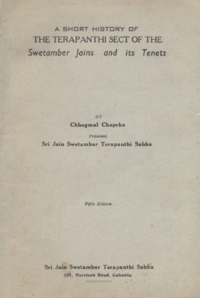- Nations, states, societies and families are all due to the association of several beings and as in this world besides the human beings, there are also various other kinds of living beings and each living being is a separate entity and unit, the development of one soul helps in the development of others as it stands out as an example. According to the Jains, by his own good actions, every living being can attain a higher stage of evolution and can ultimately reach its goal from the human stage. To free ourselves from the Karma bondage is the primary duty and it is only by right knowledge, right perception, right conduct and self-control or penance that the accumulated Karma bonds can be loosened and destroyed. Jainism shows the different modes of practising these, but if these modes are also practised by anyone professing any other religion, he also is sure to tread the path leading to Salvation.
- Before dealing with the main causes of the Karma forces it would be better, if we briefly touch upon some technical terms of Jain Philosophy.
JlVA (living beings) are subdivided into two main categories: Siddha or liberated (having no body) and Sansari or worldly beings (having bodies). Worldly beings may be divided into many different subdivisions, such as:
- Tras (moving) and Sthavar (stationary)
- The four Gatis or stages of life,
- Heavenly beings (Deva),
- Human beings (Manushya),
- Infrahuman (Tiryyanch) and
- Hellish (Naraki)
- The five classes viz.:
- One organned (having body only),
- two organned (having body and organ of taste),
- three organnied (having body, and organs of taste, and smell)
- four organned having body and organs of taste, smell and sight) and
- five organned (having body and organs of taste smell, sight and hearing): and so forth.
With the mixing up of different Karma particles, living beings acquire different shapes and stages but their inherent qualification is the same. To illustrate this by a simple example, it may be noted that just as gold may be transformed into various ornaments, but the main thing remains gold all the while, so also every living being has the same inherent quality of consciousness, although it may have different degrees of it or may be in different planes. Just as different moulds give the same gold different shapes, so also different Karmas give the soul different body and shape and qualities.
- Ajiva or non-sentient things are those which have no consciousness and which either exist by themselves or are so mixed with conscious beings that it is difficult to separate them and they are the cause of the fall of the soul from its pure state. Ajiva has five main sub-divisions:
- Dharmastikaya (or that which helps soul and matter to move),
- Adharmastikaya (or that which helps the soul or matter to rest),
- Akasasti (or space, that substance which gives shelter to the living and the non-living),
- Kal (time), and
- Pudgala (matter)
- Dharmastikaya (or that which helps soul and matter to move),
- Punya or the effect of good actions (subha karma), and Pap or the effect of evil actions (ashubha karma). Just as regulated diet increases health and irregular diet increases diseases, so also when a living being has an abundance of Punya karmas, its happiness increases and when it has an abundance of Pap karmas, its miseries increase; when both the good and the evil actions are eliminated, the soul attains Moksa or is liberated.
- Ashrava or the inflow of karmas, Samvara the stoppage of karmas and Nirjara the partial elimination of karmas may be best described by illustrations thus:
Just as water enters a vessel by any leak it has, so also karma particles enter the Jiva and this process is known as Ashrava, To stop the leak or inflow of karmas is Samvara and to pump out the incoming flow of karmas is Nirjara. All living beings, if they are not alert and if they do not stop the inflow of karmas, are liable to be bound by karma particles and this binding up of soul with karmas is Bandha (Bondage).
- Moksa is the stage of complete separation or elimination of Karmas from the Jiva and as soon as that stage is reached, the soul becomes free.
As must have been noticed from the definitions of our technical terms, it is the mingling up of soul with karma particles which is the root of all unhappiness. The Jains believe and hold that every living being has many inherent qualities. It has immense potentialities, it has immense knowledge, it is full of infinite capacity of eliminating karma-bondages, it can also attain infinite happiness and it can also endure the utmost afflictions caused by Karmas.
 Chhogmal Choprha
Chhogmal Choprha
